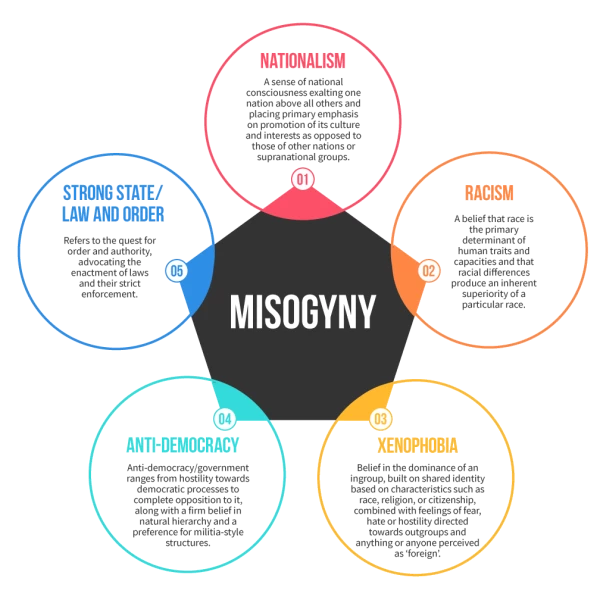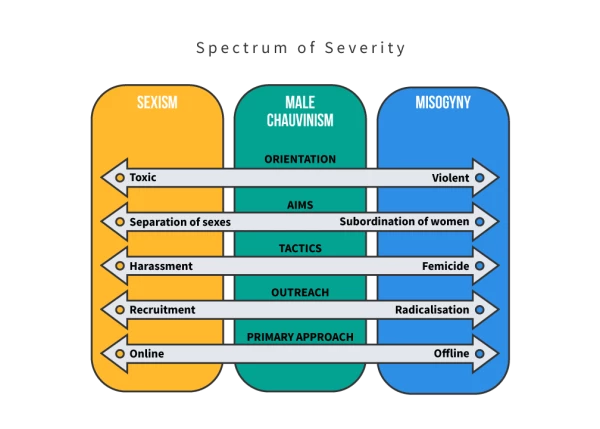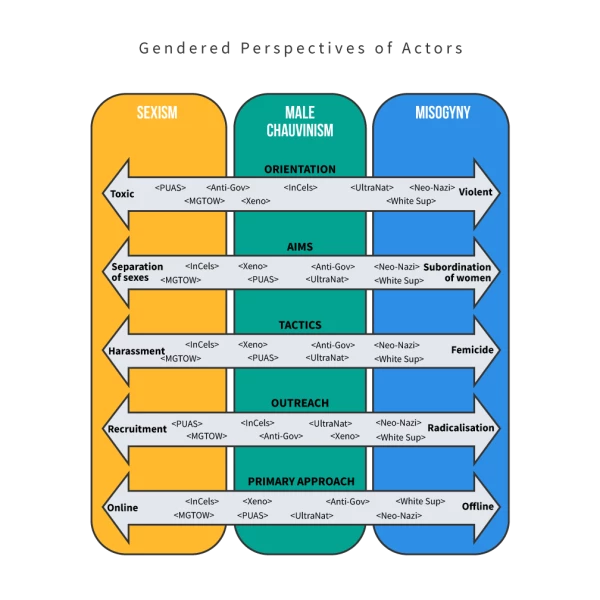A growing body of evidence suggests that gender identitynd gender ideologyl to extremism and t
Far-right extremism represents a significant security threat in both the UK and Australia, as well as in many other places around the globe. A growing body of evidence suggests that gender identity and gender ideology are connected to extremism and terrorism, and that prevention strategies should consider the gendered dimensions of radicalisation, recruitment and participation in extremist groups given the distinct experiences in these processes that can be enabled or constrained by gender. Yet, less research has been devoted to critically examining the transnational spread of far-right extremism across online channels and offline sites and how this transmission might be encouraged by misogyny and other gendered perspectives shared across various extreme ideologies and groups.
Who are the ‘far-right’?
The right-wing spectrum consists of many sub-variants of ideology; however, all actors in the right-wing landscape are – to varying degrees – ‘right of’ centre on the political spectrum. Essential features of groups and individuals on the far-right end of the spectrum include ultra-nationalism, racism, xenophobia, anti-democracy/anti-government and advocacy for a strong state. These belief systems can be held at varying levels on the spectrum, with some tending more easily to support violent expressions.
The right-wing spectrum comprises of, and is influenced by, everything from political parties and organisations to social movements, as well as the media, academic institutions and think tanks. Often the line between mainstream and extreme is blurred, with some right-wing groups combining political participation and at times violent forms of activism and expression.
The current global political and social climate, including the escalating impact of the COVID-19 pandemic, has encouraged the spread and mainstreaming of this threat, as well as the adoption and adaptation by some far-right groups of political speech, left-wing causes, and pop cultural symbols. Consequently, governments and international bodies are increasingly recognising the threat posed by the far-right, both at national and international levels.
'Far-right' is used as an umbrella term encompassing both the radical right and the extreme right on the right-wing spectrum, as defined by scholar Cas Mudde.
- Radical right individuals and organisations often seek to obtain the support of the public and outwardly condemn the use of violence – this variant of right-wing politics is widespread globally.
- Extreme right individuals and organisations typically reject democracy and support a system ruled by individuals who are ‘natural leaders’, often inspired by Fascism or National Socialism. They oppose any kind of ethnic or cultural diversity and are often open to the use of violence to achieve political goals or profess intent or narratives that might lead to or encourage others into violence.
It is important to note, as Cas Mudde does, that these categories are not fixed and often individuals and groups move between radical and extreme spaces or parts of the same group occupy both categories at the same time.
Far-right Core Concepts

- Nationalism: a sense of national consciousness exalting one nation above all others and placing primary emphasis on promotion of its culture and interests as opposed to those of other nations or supranational groups.
- Racism: a belief that race is the primary determinant of human traits and capacities and that racial differences produce an inherent superiority of a particular race.
- Xenophobia: belief in the dominance of an ingroup, built on shared identity based on characteristics such as race, religion, or citizenship, combined with feelings of fear, hate or hostility directed towards outgroups and anything or anyone perceived as ‘foreign’.
- Anti-democracy/government: ranges from hostility towards democratic processes to complete opposition to it, along with a firm belief in natural hierarchy and a preference for militia-style structures.
- Strong state/law and order: refers to the quest for order and authority, advocating the enactment of laws and their strict enforcement.
What is ‘gender’?
Gender refers to a fluid set of socio-culturally constructed norms and assumptions about what individuals should be and do. The primary categories of analysis in this field are masculinity and femininity, however the spectrum of gender identity does factor into violent extremist narratives. Assumptions about gender identity form the basis of social and political life and result in the formation of expected gender roles.
A growing body of evidence suggests that gender identity and gender ideology are interconnected with connected extremism and terrorism. Radicalisation and recruitment to extremist groups are highly gendered, for example in the narratives and tactics used and the ways in which individuals are targeted. Misogynistic views and hostile/sexist beliefs towards women held and espoused at the individual level are potential drivers of radicalisation.
Additionally, gendered messaging amongst misogynist and far-right groups online creates very real gendered expectations in the offline space, often defining the roles and expectations of women and men within these communities and their interactions more broadly in society.
What is misogyny?
Misogyny is often defined as a hatred for women or an attempt to maintain patriarchal societal roles and often manifests in harassment, coercion, sexual harassment and/or violence against women.
Although such hostile beliefs towards women can be understood as an attitude, scholars point to the fact that misogyny can also be understood as a broader societal system. This is deliberately designed as a means to uphold a patriarchal social order through coercive control, simultaneously designed to enforce women’s subordination to male dominance.
This becomes important not only when examining the different far-right ideologies but also the patriarchal systems of associated groups and the misogynist everyday practices encouraged amongst adherents.
The spectrum indicated in the diagram below increases in severity from left to right and is divided into the three main categories of:
- Sexism: discrimination against women
- Male chauvinism: belief in male dominance and supremacy
- Misogyny: hatred of women
Spectrum of Severity

Who are the misogynist actors?
There is a wide range of actors, from pick up artists to far-right extremists, that exist along the spectrum of misogyny.
While these actors may espouse a variety of gendered beliefs, it is important to acknowledge that there can be alliances and overlaps based on their misogynist perspectives which allow for, encourage and/or support extremism and violence.
The 'manosphere' – a loosely incorporated group of websites and social media communities – is an online world of men’s rights activism which often entertains gender-based discrimination and violence. It is a space in which “men’s perspectives, needs, gripes, frustrations, and desires are explicitly explored” and “[w]omen and feminism are typically the targets of hostility.” The manosphere includes a range of actors who fundamentally share the central belief that feminist values dominate and are detrimental to society and men’s rights and superiority.
While not all of these actors incorporate far-right ideological perspectives into their worldview, many of the same or similar expressions of sexism, male chauvinism and misogyny carry across these communities into more extreme expressions of far-right ideology becoming intertwined with racism, xenophobia, nationalism, etc. This often presents a situation where the online propaganda and engagement of these two spaces overlap and mix.
Some far-right groups have specifically and strategically utilised and exploited gendered narratives through their communication strategies to not only justify and legitimise hostile beliefs towards women, but also to capitalise off toxic masculinities under the guise of 'men’s rights'.
The danger is that extreme expressions of this misogyny can offer unifying themes and transference of ideology across the spectrum of actors – including violent extremist actors – and therefore can feed or be fed by extremist ideologies. Many violent extremist ideologies contain elements of misogyny, making them potentially susceptible to ideological transference; however, this transference is particularly relevant for far-right extremism, given the many existing ideological overlaps with the wide spectrum of misogynistic actors on and offline.
When thinking about the gendered narratives such actors espouse across a spectrum of misogynistic groups, it is important to consider:
- What are their violent/hostile beliefs towards women?
- What is their gender ideology?
- What are their stances towards gender norms in the group?
- How are gender power relations defined in the group?
Below are a few examples of actors on the misogynistic spectrum and their gendered narratives and ideologies:
- Pick Up Artists (PUA): men that develop and share techniques to seduce women with the ultimate aim of engaging in sexual intercourse, seeking to exploit women for personal sexual gain.
- This includes techniques to overcome ‘last minute resistance’, i.e., convincing women who do not consent to sexual intercourse to sleep with them anyway.
- PUA ‘gurus’ share their techniques and strategies in the form of books and other media, as well as holding in-person seminars and online mentoring sessions.
- Men Going Their Own Way (MGTOW): men that aim to live their life with no contact with women.
- They blame feminism for corrupting society and believe that women are dangerous to men and engage in hypergamy.
- Based on these assumptions, they believe that the only way to maintain male self-preservation is to completely dissociate from women.
- MGTOW also emphasises systemic and institutionalised bias against men (gynocentric bias), particularly in family courts when women divorce men.
- Involuntary Celibates (InCels): men who perceive themselves as unable to get a sexual partner despite wanting one, characterised by a core belief that men are entitled to sex.
- InCels consider feminism and women’s liberation as the key to men’s suffering and a denial of this 'right', simultaneously dehumanising women and promoting the removal of women’s freedom (including justifications for the use of sexual violence, slavery, and rape) in order to achieve this.
- Anti-Democratic/Government (Anti-Gov): people who believe that democracy or government is illegitimate and tyrannical.
- They often thrive off conspiracy theories around secret government interest in remaking the world.
- While these groups tend to have less overtly rigid gender role segregation (e.g., sometimes allowing women with the appropriate skill sets to contribute), they are often made up of predominately males and encourage toxic conceptions of heroic masculinity and hypermasculinity common in security forces.
- White Supremacist (White Sup): people who believe in the superiority of the white race.
- They believe in the necessity to maintain and defend the power and privilege associated with white racial dominance.
- This narrative of racial dominance is highly patriarchal and gendered, often with men framed as defenders of the white race and women as the ‘re-producers’. Racial mixing is considered abhorrent and violence against women who reproduce mixed-race children justified.
- Neo-Nazi: people who carry forward elements linked to the historical doctrines of national socialism, including antisemitism, ultranationalism, racism, xenophobia, etc.,
- They promote white supremacy and encourage violence against racial and ethnic minorities.
- They often have strict gender role expectations, with conceptions of masculinity driven by racial and physical features, as well as conceptions of women in ‘traditional’ roles of housewives and mothers of the next white generation
- Ultranationalist (UltraNat): people who support extreme expressions of nationalism, asserting national hegemony, supremacy and sometimes control.
- This often resembles fascism with xenophobic sentiment towards other nations based on perceived cultural, ethnic or racial differences.
- Often encourages patriarchal conceptions of social hierarchy including expressions of chauvinism and toxic masculinity.
- Xenophobic (Xeno): people who fear and hate anything they perceive as foreign, often resulting in extreme expressions of anti-immigration sentiment, for example.
- Expressions of this result in extreme ingroup and outgroup division, with violence sometimes justified to defend perceived national, ethnic or racial identities.
- This narrative is often gendered in that feminism is blamed for declining birth rates, which is assumed to open the door to immigration.
The following diagram helps to visualise the similarities and differences of gendered narratives across actors and how they are positioned in relation to each other.
Gendered Perspectives of Actors

It is important to note that this does not represent a complete list of actors. Additionally, these actors are usually not neatly defined, and there exists significant overlap between the expressions of misogyny in various communities. While there may be overlaps and alliances between actors in the 'manosphere', for example, and the far-right, each of these communities espouses different ideological frameworks that do have different stances towards gender norms and hostile beliefs towards women.
What are the key implications?
Gender identities and expectations offer a key 'sense of meaning' that can shape radicalisation, recruitment and participation in violent extremism and terrorism.
Despite the differing general politicised ideologies that frame both the beliefs and actions of the various actors along the spectrum, shared misogynist perspectives can act as a key point of transmission for narratives across actors, as well as perhaps providing a familiarity that can encourage individuals to move from one space to another.
No comments:
Post a Comment